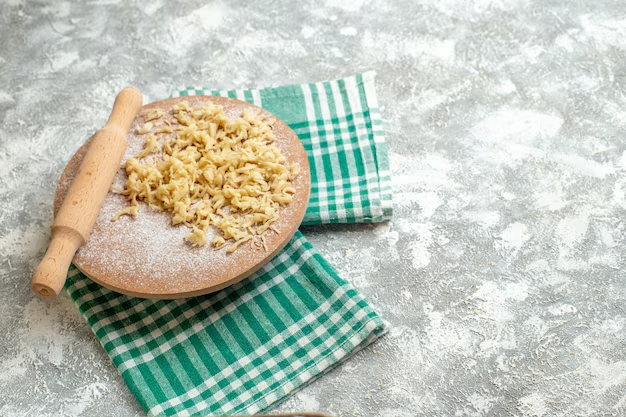How Long Does Cooked Spaghetti Really Last in Your Refrigerator?
Are you often left with a pot full of leftover spaghetti and wonder how long you can stretch its stay in the fridge? You're not alone! Proper food storage is key to minimizing waste and ensuring food safety. Today, let's unravel the mysteries of spaghetti shelf life and explore practical tips to keep your pasta fresher for longer.
🥣 Understanding Spaghetti's Lifespan: The Basics
Cooked spaghetti is a staple in many households. It’s versatile, delicious, and easy to prepare. However, once cooked, its shelf life becomes a pressing concern for many.
How Long is Too Long?
On average, cooked spaghetti can last in the refrigerator for 3 to 5 days if it’s stored correctly. Why such a short timeline? Cooked pasta provides moisture that can encourage the growth of bacteria and mold. The temperature of your refrigerator also plays a crucial role, ensuring it stays at 40°F (4°C) or below to slow down bacterial growth.
The Risks of Keeping Spaghetti Too Long
Consuming spaghetti that has surpassed its prime can lead to foodborne illnesses, a risk most home cooks wish to avoid. Signs that your spaghetti might have overstayed its welcome include:
- Strange Odors: A sour or off-putting smell can be an indicator of spoilage.
- Mold: This is the most obvious sign. If you see any, it's time to discard your pasta.
- Texture Change: Slimy or sticky texture indicates bacterial overgrowth or spoilage.
🌡️ Proper Storage Techniques
Now that you know how long spaghetti lasts, let’s dive into what you can do to maximize its shelf life.
Cooling and Storing New Spaghetti
When you’ve got freshly cooked spaghetti, let it cool slightly before storing. Piping hot pasta can raise the temperature inside your fridge, creating a breeding ground for bacteria.
Quick Tips for Storing Spaghetti:
- Use Airtight Containers: This is key to preventing odors from the fridge affecting your spaghetti and vice versa.
- Shallow Containers: These allow the pasta to cool more quickly.
- Label Your Containers: An easy way to remember when you cooked it and avoid any mix-ups in the fridge.
Freezing Spaghetti for Longevity
If you find yourself unable to eat your spaghetti within the recommended timeframe, freezing is an excellent option. Properly stored frozen spaghetti can last for up to two months without a significant loss in quality.
Steps to Freeze Spaghetti:
- Portion Control: Divide your spaghetti into meal-sized portions.
- Use Freezer Bags or Containers: Ensure they are sealed tightly to prevent freezer burn.
- Consider Sauce: Some sauces, particularly dairy-based ones, may separate or become too watery upon reheating. Freeze them separately if possible.
🧑🍳 Reheating Spaghetti: Keeping It Tasty
Whether you’re reheating from chilled or frozen, maintaining the quality and safety of your spaghetti is essential.
Methods for Reheating:
- Stovetop: Add a splash of water or broth and gently reheat over medium heat until hot throughout.
- Microwave: Use a microwave-safe dish, cover, and stir occasionally to ensure even heating.
- Oven: Less common, but you can reheat in a covered dish at 350°F (175°C) until fully warmed.
Reheating Tips:
- Even Heating: Stirring occasionally can prevent hot spots and ensure even warming.
- Avoid Overheating: This can cause your spaghetti to become mushy.
🍝 Delicious Spaghetti Variations to Spice Up Your Leftovers
Tired of eating plain spaghetti? Jazz up your leftovers with these ideas:
- Spaghetti Frittata: Mix with eggs and bake for a delicious brunch dish.
- Spaghetti Stir-Fry: Combine with vegetables and a splash of soy sauce for a quick stir-fry.
- Pasta Salad: Toss with fresh vegetables, vinaigrette, and protein for a refreshing meal.
🍽️ Waste Not, Want Not: Creative Spaghetti Uses
Sometimes, you may end up with more pasta than you can consume. Here are some creative ideas to put it to good use rather than seeing it end up in the trash.
Makeover Leftover Meals:
- Baked Spaghetti: Layer it with cheese and veggies, then bake for a new take on lasagna.
- Soup Add-In: Stir into vegetable or chicken soup for added heartiness.
DIY Snacks:
- Spaghetti Pancakes: Create a savory pancake by mixing with egg and frying until crispy.
- Pasta Chips: Season and bake for a crunchy snack.
🍃 Sustainable Practices for Pasta Storage
By being mindful of how we store and use our food, we contribute to more sustainable practices around the home.
Tips for Reducing Spaghetti Waste:
- Right-Sizing Portions: Use a food scale to measure the right amount to cook based on servings.
- Composting: If spaghetti goes bad, consider composting as an eco-friendly disposal option.
Visual Quick Guide to Spaghetti Storage & Use 🚀
| Action | Duration | Storage Tips | Reheating |
|---|---|---|---|
| Refrigerate | 3-5 days | Store in airtight, labeled containers | Use microwave, stove, or oven |
| Freeze | Up to 2 months | Divide into portions, use freezer bags | thal in warm water or fridge |
👩🍳Key Takeaways:
- Store spaghetti promptly, using airtight and shallow containers.
- Freeze if storage time exceeds 5 days for up to 2 months.
- By following these tips, you’ll ensure your spaghetti is safe and enjoyable while also reducing food waste.
Next time you cook up a storm of spaghetti, rest easy knowing you have everything in place to make your pasta stretch its shelf life and stay delicious.
